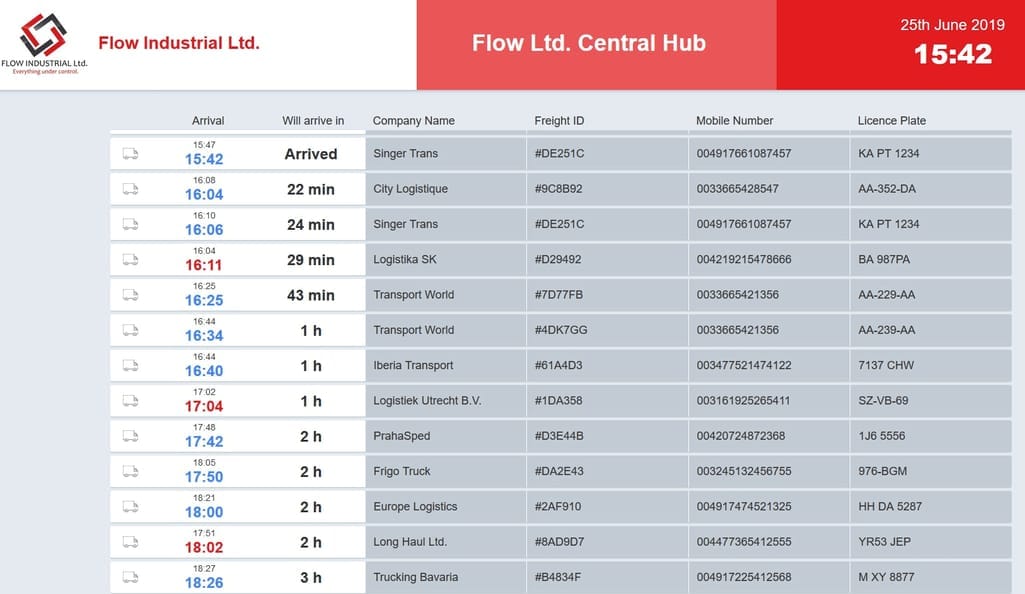I told you I’d be there in 5 minutes. Stop calling me every half an hour!
How often do you have to wait for a friend who’s running late? It’s amazing how some people are so bad at time management while being so good at making up reasons for chronic lateness. It’s traffic, broken vehicles, alarm problems, alien visits... Whatever the case this time, you swallow another excuse, have your time wasted, and probably feel annoyed, angry, or upset, depending on your character type.
In business, time is money. And in the logistics industry, where you often have to connect multiple processes and people into a precise sequence of operations, the price of delays is too high and the value of accurate planning is immeasurable. Just to illustrate the scale, remember Suez Canal being blocked by the Ever Given containership in March 2021? Experts calculated that it was holding up trade with a total daily value of $9.6 billion!
In this article, we’ll explore what stands behind those ETA, ETD, and ETC acronyms and what can help you take the guesswork out of your time estimations.
What are ETA, ETD, and ETC?
ETA or estimated time of arrival is the time when a vehicle or person is expected to reach its/their destination. The calculation is based on the planned duration of the route. In logistics, it refers to the transportation of goods and is typically used to inform customers of the time the vehicle carrying their freight will arrive.
ETD can have one of two meanings.
- Estimated time of departure is the time when the transport departs from the starting point. Typically, it refers to ocean/air cargo carriers leaving the port/airport of origin. This estimate is especially important for shippers who send goods internationally and work with consolidators.
- Estimated time of delivery is the final point of the supply chain. It’s the time when the package or shipment is expected to be handed over to the final customer. It’s mainly used in the last mile delivery settings.
Since both interpretations are used in the logistics industry, we’ll extend the ETD to ETDep and ETDel to avoid misunderstandings.
ETC or estimated time of completion is also sometimes called closing and means the time when certain activities are completed. It can refer to service provision or the loading/unloading process.
ETA vs ETDel
These two terms are different since arrival time doesn’t always equal delivery time. For example, in maritime shipping, ETA can refer to the time the vessel enters the port, but ETDel would be the time cargo is transferred to the warehouse. It can also be important for courier services, e.g., in case of delivery to a multi-office business building. Here, ETA is the time the courier arrives, while ETDel is the moment packages are delivered to specific consignees.
ETDel vs ETC
The main difference here is the field of application. As we said, ETDel refers to the actual handing over of shipments or goods, while ETC is often used in the service industry. For example, if you have a 10 am appointment for equipment maintenance that is expected to take 3 hours, ETC is 1 pm.
Why are ETA, ETD, and ETC important?
The main goal of these estimates is to always be informed about the timing of supply chain operations and the changes that occur. It’s crucial for all parties involved in the transportation process.
Ports/airports must know the ETA and ETDep to efficiently plan their operations and reduce congestion. Moreover, it’s important to monitor the real-time changes in ETA/ETDep to be able to redirect vessels or airplanes in case of delays.
Carriers need accurate time estimations to support the scheduling process. Truckers should control drivers’ hours of service and arrange future loads; air carriers must plan on the fuel usage; and ship owners want to secure chartering contracts well in advance. Real-time visibility allows dispatchers to immediately reschedule in case of any delays or disruptions.
If a carrier miscalculates the ETA and gets delayed, it often results in substantial fines. And besides, customers want to track their shipments and be aware of the delivery stage in real time so it’s about their satisfaction as well.
Complementary service providers include dockers, cranes, forklifts, tugs, and other personnel and equipment involved in the loading/unloading process. They often operate on a rental basis and need carriers’ ETA to schedule their activities.
Consignees are the ones that rely on accurate planning the most since it’s the basis of efficient inventory management. Knowing the exact time goods are delivered, businesses can plan their manufacturing, warehousing, yard, and sales activities. It allows for avoiding both overstocking and stockouts as well as staff idling and yard congestion.
In addition, receivers are usually the ones who pay, for example, for crane rental. Delays can cause extra expenses for rental period extension, detention, or arranging for an alternate time. The same about port inspections, demurrage, and so on. And if you deal with perishable goods, late deliveries can be the reason for significant loss.
Okay, so now it’s obvious that these estimations are an essential part of the supply chain process. The question is how to make their results as accurate as possible?
Note that in our overview, we’ll focus on ETA calculations as the most crucial and prone to change due to the influence of external factors.
How to calculate estimated time of arrival?
In logistics, multiple factors impact shipping duration. They include
- route distance between origin and destination,
- vehicle/vessel average speed,
- number and duration of intermediate stops,
- weather conditions,
- time needed for refueling,
- traffic,
- available hours of service and mandatory rest periods for truck drivers, and so on (not to mention all sorts of emergency situations).
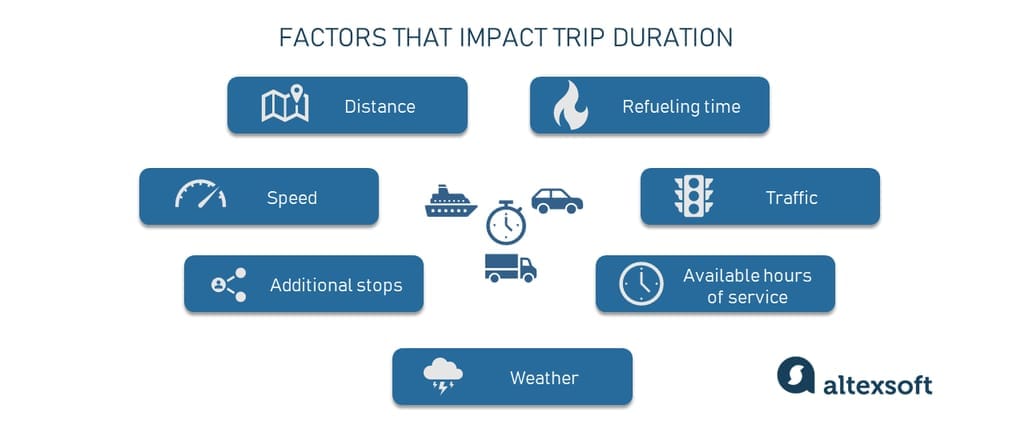
What impacts ETA
As we all know from middle school curriculum, time equals distance divided by speed. So, if you know the route distance and transportation average speed, you can easily make a rough estimate of, say, truck arrival time. You can do it manually or with versatile computational tools like Excel.
This approach is simple and doesn’t require any investment or development effort, but we all understand that such “predictions” are far from reality.
Since customers become more demanding and want to know exactly what’s happening with their goods, shippers and carriers have to keep up and improve their service, providing the most precise information. Currently, technology enables us to track shipments in real time, create data-based forecasts, and make accurate time estimates. So, let’s take a look at more technological options.
ETA calculation as part of tracking and routing tools
Today, everybody is familiar with navigation systems. Just as you use Waze or Google Maps when driving your car, most carriers use specialized software to plan their routes. In the trucking, delivery, or service industry, it can be a part of, for example, a fleet management system or a standalone routing tool. Air and ocean carriers also rely on satellite navigation systems for positioning and timing purposes (e.g., Air Navigation Pro, StormGeo s-Routing, AdrenaShip, etc.).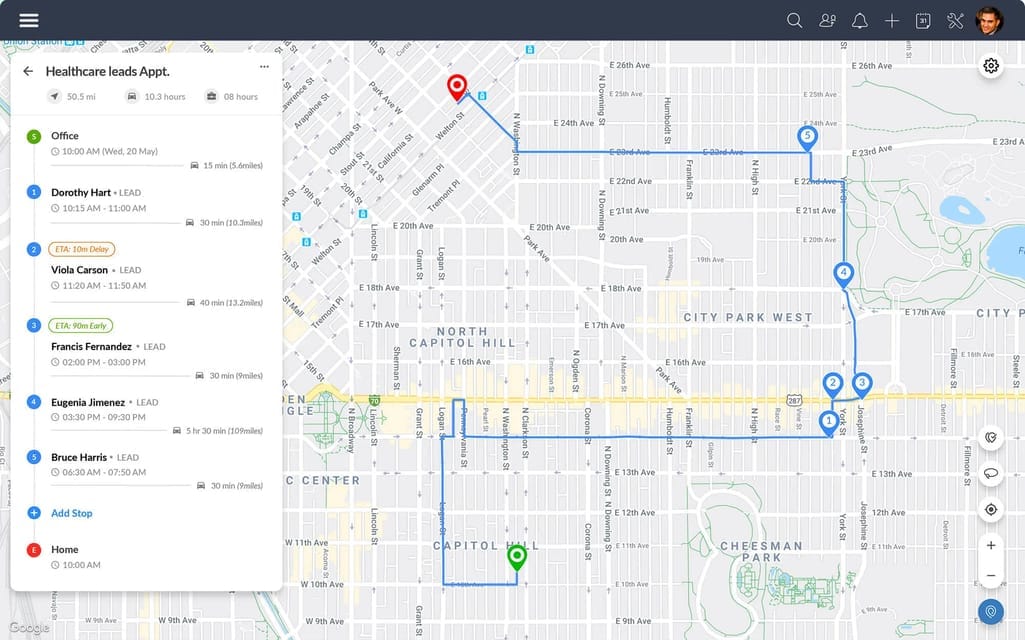
RouteIQ routing tool by ZohoCRM
All these platforms make more advanced and accurate calculations, taking into account such additional fluctuating factors as weather, traffic, delays, port congestion, etc. Routes are tracked in real time and adjusted if necessary. ETAs are provided automatically and also are corrected constantly.
If you are, for example, an eCommerce business, you’re probably dealing with shipping carriers that offer tracking functionality. Here, ETAs also come along by default. We have a detailed article about integrating shipment tracking from different providers, e.g., API aggregators, parcel couriers, cargo carriers, freight forwarders, etc.
Even though tracking and routing tools display an ETA as their essential part, you might need a more feature-rich solution. Your navigation system might not be as exact or convenient as you need or you want wider functionality.
There’s a number of focused solutions that specialize in calculating ETAs for your trips. Such platforms collect external data from a variety of sources in real time to provide the most exact estimates. You can use them as separate tools or integrate them into your existing system via APIs (learn more about API integration from a dedicated post if you’re not quite familiar with the concept). Note that you’ll have to engage a developer to set up the connectivity.
Here, we’ll focus on ETA calculations for land and sea carriers as most vulnerable to changes due to external influence. So, let’s see what’s on the market.
Standalone ETA calculators in land transportation
In the trucking, delivery, or service industries, delays are almost inevitable. Bad weather, blocked roads, flat tires, whatever hesitations at loading/unloading stops or appointments -- it all costs time and postpones planned arrival.
If you are a dispatcher of delivery or maintenance services and coordinate multiple drivers with numerous stops daily, you need a powerful tool with automatic notifications. Otherwise, your life will become a nightmare, full of endless calls and unhappy customers. Good news -- there are a number of solutions that can help.
PTV Drive&Arrive: an industry leader with multiple sharing options
An obvious industry leader here is the PTV Drive&Arrive ETA calculator. This tool comes with RESTful JSON APIs (check their open API information) so you can request ETA calculations and get results directly through your internal system.
First, you create your trip in your routing tool and transfer its details to the PTV calculator. To accurately define route duration and ETA, PTV Drive&Arrive platform gathers a lot of additional data:
- telematics information from vehicles, driver apps, or telematics aggregators;
- map data (including traffic conditions, patterns, and predictions, toll data, etc.); and
- truck-specific restrictions (low bridges, tunnels, weight limits, U-turns, etc.).
Then, there are several ways you can share calculation results, depending on your operation model.
- If you work with warehouses, you can enable them to track multiple incoming trucks in real-time by visualizing all the deliveries on the web-based arrival board.
PTV Arrival Board
2. Another option is integrating the ETA calculation and notification functionality into your existing fleet management system, warehouse management software, order management tool, or any other platform you use to operate your business. This way, you’ll be able to track ETAs from your interface.
3. You also get a unique ID number for each trip that can be shared with all stakeholders. They can track the trip progress via a free web-based service PTV Trip Viewer or opt for subscribing to SMS or email notifications.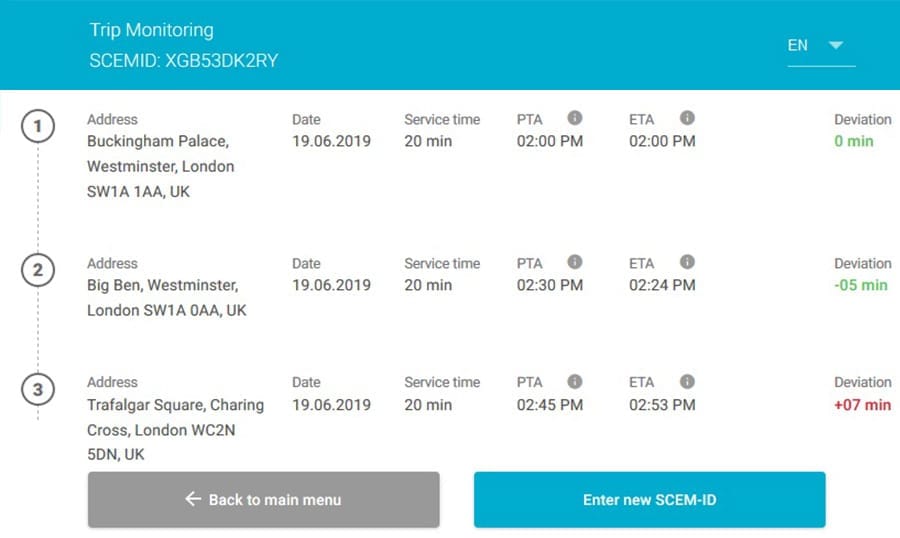
PTV Trip Viewer
PTV Drive&Arrive has a set pricing of 15 cents per each trip monitored.
Agheera: based on the big telematics consolidator
Agheera Arrival Monitoring is based on the industry-recognized telematics aggregator. The Track.Agheera platform collects data from numerous telematics devices of different manufacturers and provides real-time ETAs.
The Agheera monitoring tool provides a convenient arrival board with an overview of incoming trucks. Such real-time visibility allows warehouse and yard operators to optimize their scheduling and ramp processes.
You can also set up customized notifications to inform your staff and/or customers about ETA deviations.
Agheera doesn’t provide open API documentation or pricing plans, so you’ll have to contact them to learn more about integration options.
MapTrip: GPS truck-focused tool with rich API suite
MapTrip is a professional GPS tracking solution made for trucking. For routing and ETA calculations, MapTrip considers all truck-specific restrictions such as low tunnels, sharp U-turns, narrow roads, and so on. You can also set up truck dimensions, choose load type (overdimensional, hazardous, etc.), and indicate other preferences such as avoiding toll roads.
To get ETA calculation results and notifications, you can use their app interface or integrate its functionality with your own system. MapTrip offers a suite of APIs that allow you to customize your route planning and a Navigation SDK to create your own apps.
MapTrip also provides a wide range of learning materials to support developers, including YouTube videos, detailed tutorials, and code examples on GitHub.
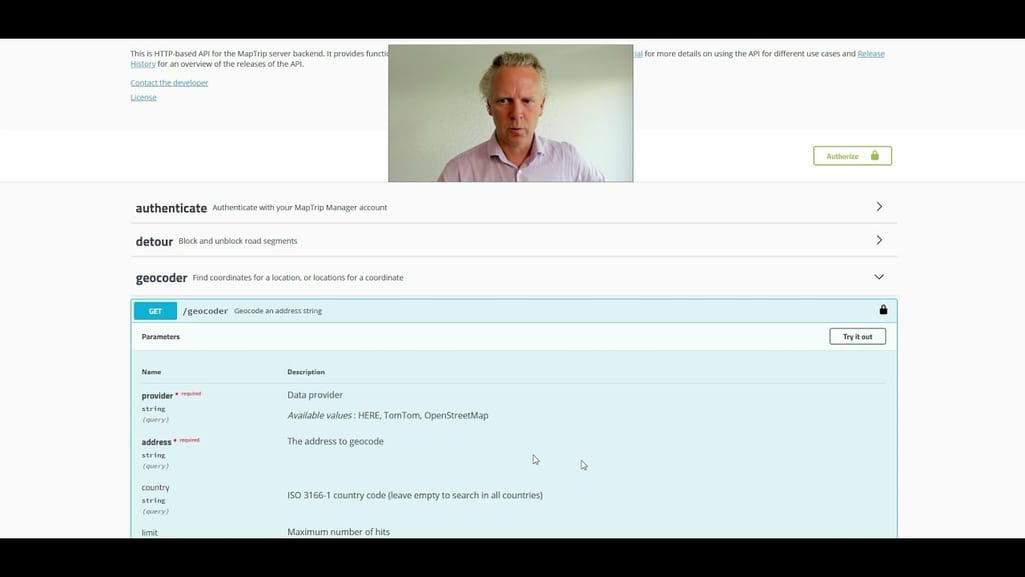

MapTrip Server API overview
Cargoclix: convenient integration with SLOT time window management tool
The ETA Management module of Cargoclix seamlessly integrates with its SLOT tool that’s often used to manage warehouse and yard operations. So if that’s what you’re currently utilizing, it’s the best fit for you.
The ETA calculations consider the vehicle’s current position, distance to destination, traffic, and truck type. Estimation results are displayed directly within the SLOT time management solution. That allows schedulers and time operators to adjust the planning and avoid idling and yard congestion.
This ETA module can also be used as a standalone app, but you’ll have to contact their team to know how you can connect it to other platforms.
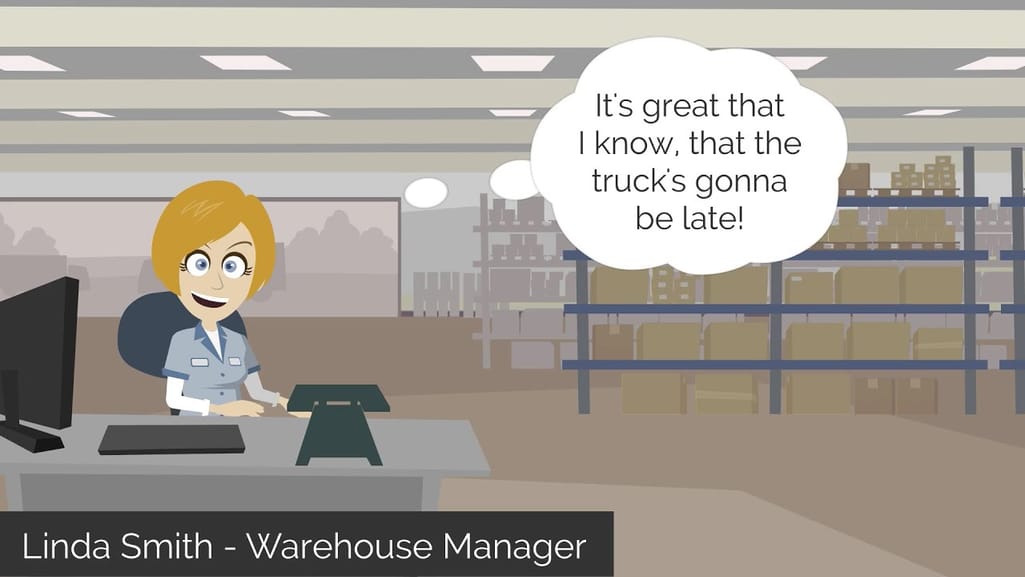

Brief overview of Cargoclix ETA app
Standalone ETA calculators in maritime shipping
The ocean is changing just as much as roads are. So, the need for real-time tracking is just as big. There are software tools that apply artificial intelligence and machine learning methods to analyze both historical and real-time maritime data and make accurate ETA predictions.
Sinay ETAC: consolidated dashboards and a family of related tools
Sinay ETAC Module uses information from a ship’s AIS (Automatic Identification System) as well as ocean and port data to track the position of vessels globally. The module is connected to a global ship database so you can monitor separate vessels or the entire fleet.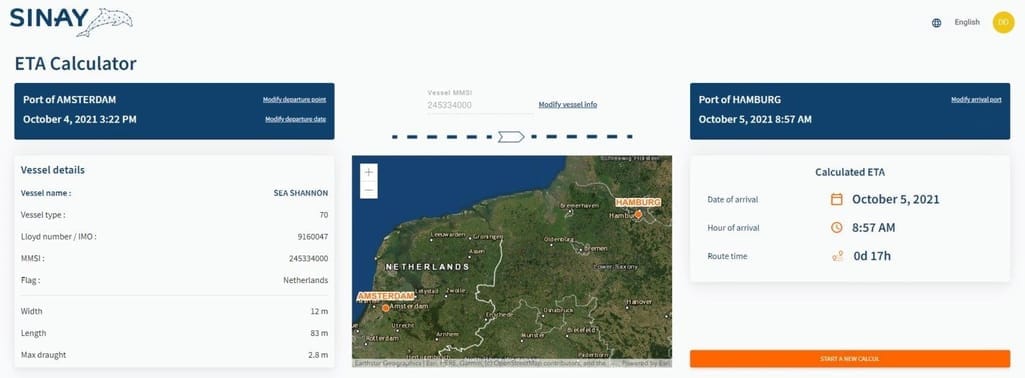
Sinay interface
To track vessels from a web interface, you have to enter the ship’s MMSI or IMO number, choose departure port and time, and add arrival position. After that, you’ll get access to a dashboard with all vessel and route details, a map, statistics, the port of arrival, and predicted ETA. Sinay also indicates a trust index which shows how likely the ETA is to change.
A consolidated ETA dashboard of multiple ships can be created. This option is especially useful for ports to monitor incoming vessels and their predicted ETAs.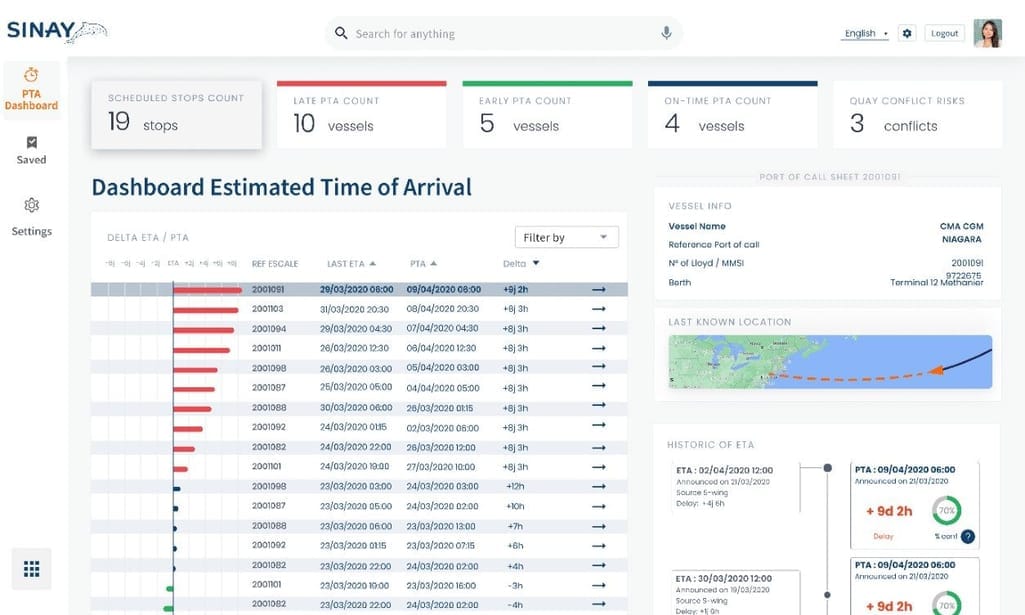
Sinay port ETA dashboard
You can also establish API integration to get the ETA information to your system, but note that you’ll have to contact them directly for details since they don’t provide open documentation.
Sinay offers a suite of tools that can be used to support your maritime operations including route planning and optimization, fleet statistics, consumption prediction, and so on. So, if you’re already using their software or need a comprehensive platform, it’s a good option.
FleetMon: map views and a variety of APIs
FleetMon Explorer is another browser-based provider of maritime data. It also has an extensive vessel database for tracking global ocean traffic and operations in real time.
You can monitor ships on a map or choose vessels from the list. FleetMon has a user-friendly interface that compactly displays all the vessel and trip related information, including ETA.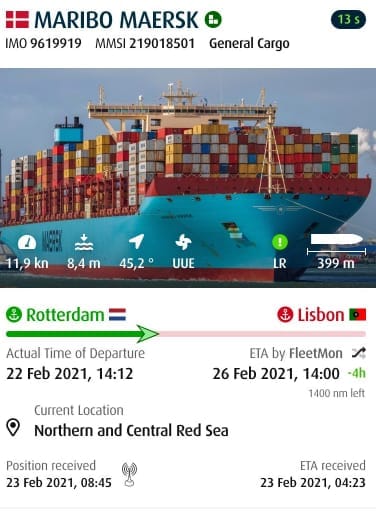
FleetMon Explorer live tracking
Besides using the browser interface, you can connect via API and request trip information directly from your system and get ETA calculations. FleetMon provides a rich suite of JSON APIs for different purposes. Once you connect, you can receive the needed data with custom intervals or just once if necessary. Check the detailed FleetMon API documentation to learn more.
FleetMon also offers a mobile app to access vessel information and track your fleet right from your device.
Custom ETA calculators
All businesses are different, and even though there’s a wide variety of diverse tools on the market, sometimes it’s not enough to seamlessly fit into your workflow and meet your unique needs.
ETA calculation is a complex task that demands considering multidimensional data from different sources. Off-the-shelf solutions are often unable to provide the desired accuracy. In that case, consider building a custom solution tailored to your specific business requirements.
Extensive research has been conducted to find the best approach to calculate arrival times. There are three main methods (and a separate hybrid group that combines several of them).
The speed/time approach calculates ETA based on information about past trips using only two parameters: the average travel time and the average speed. It’s widely used due to easy implementation and short computational time, but it strongly relies on stable traffic conditions which is rare, so its accuracy is the lowest compared to the other two.
The statistical based approach applies statistical models to predict ETA based on past estimations and other historical data. They consider the impact of a bigger number of factors (traffic congestion, dwell time, etc.) and can build trends assuming that what happened before will happen again, but the calculation results are still far from being precise since real-time data isn’t utilized.
The machine learning (ML) based approach is more time-consuming and demands a lot of data for training models. However, modern studies show that this method promises to give the most accurate prediction due to processing large amounts of diverse, often real-time data and identifying unobvious patterns and dependencies. We recommend you to visit our posts about machine learning and data engineering for a general understanding of how it works, who has to be engaged, and what results you can get.
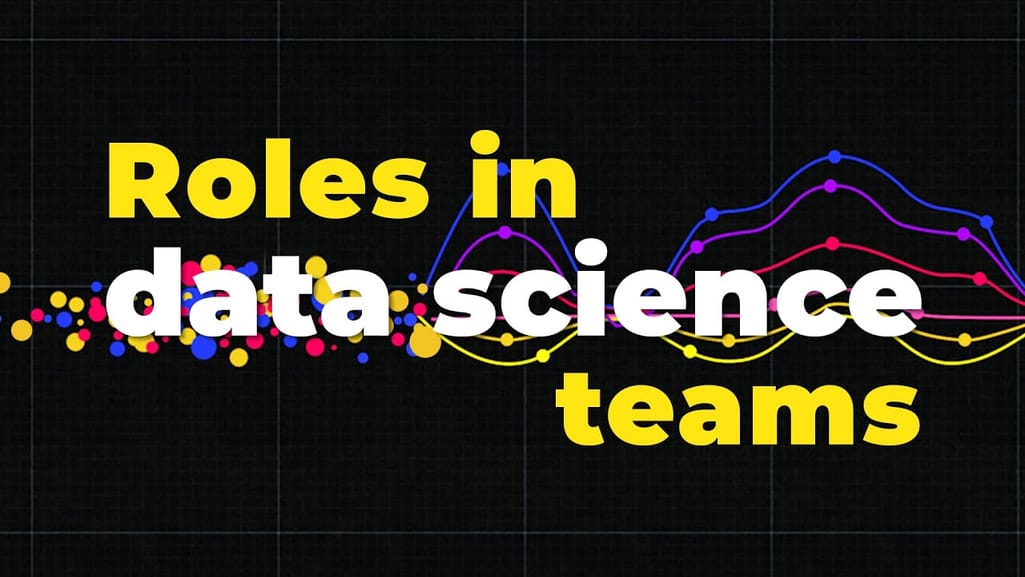

Roles in the data science team
Data sources for ETA calculations
To build an accurate, ML-based ETA calculator for trucking, you have to gather data about factors that impact your calculations.
- Route information (origin and destination) and details (number of stops, delivery time windows, preferred route, etc.).
- Geolocation information (real-time traffic conditions, accidents, speed cameras, and so on). You can connect to such global data providers as TomTom, Here, or OSM. If you have a routing tool, it probably gets information from one of them so check with your provider to see if you can integrate via APIs to have routing and tracking in one system.
- Telematics information that includes the vehicle’s speed and geoposition. You can connect to telematics devices installed on your fleet's vehicles, collect data from specialized driver apps, or partner with a telematics aggregator such as Agheera or Timocom.
- Weather information, both historic, current, and forecasted. There are lots of weather APIs. For example, check OpenWeather or Tomorrow.io. Some map data providers also offer weather APIs.
- Additional restrictions and factors such as vehicle/cargo type and dimensions, drivers’ available hours, driving style, etc.
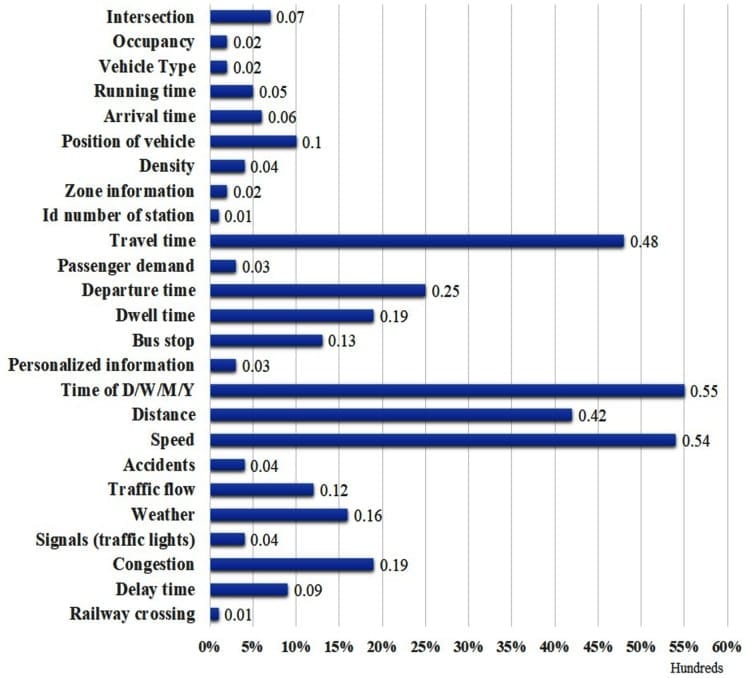
Factors that impact ETA. Source: A review of travel and arrival-time prediction methods on road networks: classification, challenges and opportunities
For an ETA calculator for maritime shipping, data inputs will be different.
- Route information.
- Marine weather information that includes data about winds, waves, tides, ice coverage, and all that. For example, it can be obtained from stormglass.io or WorldWeatherOnline.
- AIS information about vessels’ positions, speed, and course. It’s similar to telematics data, but to get the full picture of ocean traffic, connect to an aggregator such as AISHub, Spire, or MarineTraffic. Typically, it’s a better option than building your own receiving station. Besides, such platforms also provide valuable port data.
- Additional restrictions such as vessel and cargo type.
Effective ML methods to predict ETA
ETA calculation belongs to regression problems of machine learning as it requires prediction of a quantity — unlike classification where a class label is forecasted. Among numerous ML techniques to solve regression tasks, there are several winners.
According to recent research from Sweden's Chalmers University of Technology “Calculation of estimated time of arrival using artificial intelligence,” ensemble methods — namely, random forest and stacked generalization — give the most accurate arrival time predictions.
A random forest algorithm consists of multiple decision trees merged together to obtain the most accurate results. Imagine yourself choosing which car to buy and asking around for advice. As you collect many opinions, you choose the option that was recommended the most. Basically, that’s the principle of random forest technique.
Stacked generalization or stacking is another ensemble learning technique that uses predictions of multiple models as inputs for a new model. This final model combines or blends the different forecasts to achieve greater accuracy. It’s similar to you checking the weather forecast on different websites, calling weather stations, and asking your grandma about folk superstitions just to make your own predictions, combining the knowledge from all these diverse sources.
Another study by the German Technical University “Grand Challenge: Real-time Destination and ETA Prediction for Maritime Traffic” suggests using feedforward neural networks (FNN) for ETA calculation. FNN is the simplest type of neural network. It takes as input coordinates, course, speed, and a number of other parameters useful for ETA tasks, processes them through hidden layers, and returns the prediction via the output layer. In the above-mentioned study, the FNN with an input layer of 200 neurons and only one hidden layer of the same size showed the best results. Please read more about deep learning and neural networks in our dedicated article.
Visualization and data sharing
As you obtain time estimates, they have to be visualized either within an existing system or via arrival board or portal, depending on your needs. Also, notifications to different stakeholders have to be set up with options of sharing via diverse communication channels (email, SMS, link to portal, API connection to their system, etc.) and with varied regularity (once, hourly, daily, only if ETA changes, etc.).
You can develop your ETA solution on the basis of your existing software or, if you’re building from scratch, you can partner with the location technologies provider and make use of their environment (e.g., Here Workspace).
So, buy or build?
The choice whether to buy or build is yours. When making a decision, you have to consider available resources, including software, hardware, and experienced staff. Another important question is how soon you need the software since custom development is usually very time consuming.
Many off-the-shelf solutions offer comprehensive functionality and sufficient flexibility to adapt to your needs, but you’ll most probably still need to build integrations and tailor it to your needs and workflow.
If you opt to develop your custom software, you can fine-tune its functionality to solve your specific business issues, but it’s not the best option if you’re on a tight budget or timeframe.

Maria is a curious researcher, passionate about discovering how technologies change the world. She started her career in logistics but has dedicated the last five years to exploring travel tech, large travel businesses, and product management best practices.
Want to write an article for our blog? Read our requirements and guidelines to become a contributor.


